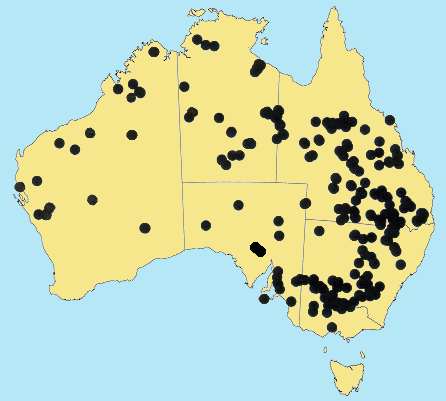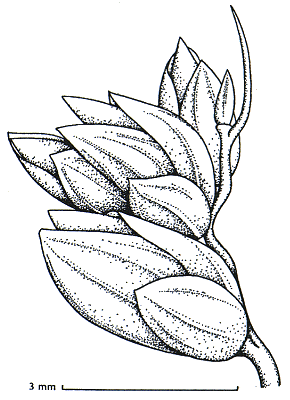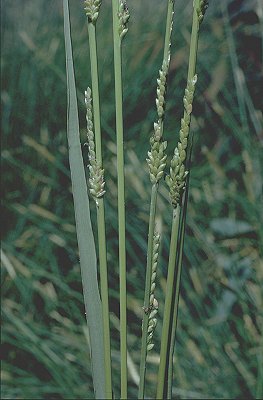Paspalidium jubiflorum (Trin.) D.K.Hughes.
Bull. Misc. Inform. 317 (1923).
Classification. (GPWG 2001) : Subfamily
Panicoideae. Paniceae.
Basionym and/or
Replacement Name: Panicum
jubiflorum Trin., Gram. Panic. 130 (1826).
Type of Basionym or
Protologue Information: HT: Lindley s.n., Australia (CGE?).
Key references
(books and floras): [1952] C.A.Gardner, Flora of Western Australia 1
Gramineae (248), [1981] M.Lazarides in J.Jessop (ed)., Flora of
Central Australia (478), [2002] D.Sharp & B.K.Simon, AusGrass,
Grasses of Australia, [2006] J.Jessop, G.R.M.Dashorst, F.M.James, Grasses
of South Australia (481 as Setaria), [2008] S.W.L.Jacobs,
R.D.B.Walley & D.J.B.Wheeler, Grasses of New South Wales (325).
Illustrations:
[2006] J.Jessop, G.R.M.Dashorst, F.M.James, Grasses of South Australia (481, fig. 414 as Setaria), [2008]
S.W.L.Jacobs, R.D.B.Whalley & D.J.B.Wheeler, Grasses of New South Wales,
4th edn (325).
Habit.
Perennial. Rhizomes present. Culms erect or geniculately ascending or
decumbent, 30–120 cm tall, 4–7 -noded. Mid-culm internodes hollow, glabrous.
Mid-culm nodes glabrous. Lateral branches simple or sparsely branched or
branched. Ligule a fringed membrane, a ciliate membrane, 1 mm long. Leaf-blades
7–25 cm long, 2.5–10 mm wide. Leaf-blade surface scaberulous or scabrous.
Inflorescence.
Inflorescence compound, a panicle of racemes. Racemes 6–16, appressed,
flexuous, 1–4 cm long, 4–6 mm wide, bearing 13–50 fertile spikelets on each.
Central inflorescence axis 8–36 cm long.
Spikelets.
Spikelets pedicelled. Fertile spikelets 2-flowered, the lower floret barren
(rarely male), the upper fertile, comprising 1 basal sterile florets,
comprising 1 fertile floret(s), without rachilla extension, elliptic or ovate,
laterally compressed or dorsally compressed, 2.4–3.1 mm long.
Glumes.
Glumes thinner than fertile lemma. Lower glume orbicular, membranous, without
keels, 3–5 -nerved. Lower glume surface glabrous. Lower glume apex muticous or
mucronate. Upper glume elliptic, 2.3–2.9 mm long, membranous, without keels,
5–9 -nerved. Florets. Basal sterile florets 1, barren, without
significant palea. Lemma of lower sterile floret 100 % of length of spikelet,
membranous, 5 -nerved.
Fertile lemma 2.3–3 mm
long, without keel. Lemma apex mucronate.
Continental
Distribution: Australasia.
Australian
Distribution: Western Australia, Northern Territory, South Australia,
Queensland, New South Wales, Victoria.
Western Australia:
Gardner, Fitzgerald, Dampier. Canning, Fortescue, Ashburton, Carnarvon. Irwin. Northern
Territory: Darwin & Gulf, Victoria River. South Australia: Lake
Eyre, Gairdner-Torrens Basin, Flinders Ranges, Northern Lofty, Murray, Southern
Lofty, Kangaroo Island, South-eastern. Queensland: Burke, Darling Downs,
Gregory North, Leichhardt, Maranoa, Mitchell, Moreton, South Kennedy, Warrego,
North Kennedy, Gregory South. New South Wales: North-Western Slopes,
Central-Western Slopes, South-Western Slopes, North-Western Plains,
South-Western Plains, North Far Western Plains. Victoria: Murray Mallee,
Riverina, Volcanic Plain, Wimmera.
Notes.
Presence of a flat membranous margin on the upper lemma makes this species
unique. It is closely related to P. flavidum.
In Brigalow forests,
tropical and subtropical sub-humid woodlands, temperate sub-humid woodlands,
semi-arid shrub woodlands, acacia shrublands, arid tussock grasslands, and arid
hummock grasslands. Flowers mostly Mar.-Aug.




